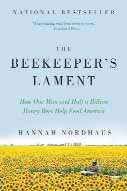SEJournal Online is the digital news magazine of the Society of Environmental Journalists. Learn more about SEJournal Online, including submission, subscription and advertising information.

BookShelf
The Beekeeper's Lament: How One Man and Half A Billion Honeybees Help Feed America
By Hannah Nordhaus
Harper Perennial, $14.99 (paperback)
Reviewed by KATHLEEN REGAN
It says something when you find yourself returning to a book again and again.
Hannah Nordhaus’ The Beekeeper’s Lament contains a wealth of incredibly accessible information about honeybees in fascinating detail.
It describes the scale and economics of one agricultural practice that is supported by and, in turn, supports beekeeping on a large commercial scale. It is also the story of one beekeeper, whose love of his honeybees and generosity with his time and knowledge make this fact-packed book such a good read.
Honeybees are admirable the way humans fancy themselves or desire to be — industrious, brave, loyal, cooperative, orderly. They are the good citizens of the insect world and provide us with a product we love — honey, the sweetest natural substance on Earth. Those qualities make honeybees easy to exploit for profit and both vulnerable and resistant to outside threats.
But right now it appears that the bees may be losing.
The hurdles facing honeybees in the world of modern industrial agriculture are many and complex.
As more U.S. cropland has been used to plant corn, less has been planted with crops that bees pollinate.
Corn is not one of those. Hay (alfalfa, clover, and mixed crops) used to be harvested after flowering, by machines that didn’t work very fast. Bees had plenty of time to collect pollen from the flowers before they were cut. But hay is more nutritious as animal feed if it is harvested before flowering.
Now, thousands of acres are cut in just a few days, never having flowered, so are no longer available to honeybees. Another food source gone.
Although nearly one hundred commercial crops in the United States depend on honeybee pollination, almonds are by far the biggest economically. Over half of all commercially managed U.S. honeybees are moved to central California every February to pollinate the almond orchards.
However, almonds bloom in February, when honeybees normally would still be in winter dormancy, and they bloom for a very short period of time — just a few weeks.
After blooming, almond orchards are “deserts” for honeybees, due to pesticides used on the trees and herbicides used on the ground under the trees to eliminate understory vegetation.
Hives must be highly managed in order to have honeybees ready to work at full capacity months before bees are out and about. Their winter rest period is therefore short, and their food supply must be supplemented by their beekeepers, usually in the form of corn or sugar syrup.
This book provides an excellent description of management practices used to keep hives strong so that bees will come out of winter dormancy early and ready to work the almond flowers, which represent beekeepers’ primary source of income.
Honeybees have suffered massive die-offs for as long as humans have been observing them.
Before colony collapse disorder (CCD) there were foulbrood (bacterial), chalkbrood (fungal), wax moths (whose larvae feed on wax comb), nosema (diarrheal), tracheal mites, fire ants, hive beetles, and more recently, Crazy raspberry ants, Kashmir bee virus, Israeli acute paralysis virus, black queen cell virus,and varroa mites.
“Bad things have been invading beehives for a long, long time. But in the last 30 years, they have come faster, and faster, in wave after breathless wave. For that we have the almond to thank,” according to the book.
But it’s not only almonds. The chapter on CCD explores every theory that has been proposed to explain it, with no clear conclusions.
Recent work (including some that has appeared since this book came out) indicates that a combination of factors is involved.
Maybe, like us, honeybees can’t live on just one or two foods.
In one section of the book, readers learned how “research has suggested that bees may be suffering from the same kind of malnutrition afflicting humans who eat processed junk food.”
Sprawl, monocrops, weedless gardens and a general decline in pastureland have “made it hard for bees to find a suitable diversity of nectar and pollen sources,” the book stated.
The combination of stress from being hauled cross country,early hive activity stimulated by corn syrup, relentless exposure topesticides, and exchange of disease vectors with other bees whenthey are all together in the almond orchards — could be death by a thousand cuts.
John Miller, who shares star billing with the honeybees, conducts his business on a staggeringly large scale.
But whatever one thinks of industrial agriculture, Miller is likeable. He loves his bees, he takes excellent care of them, and it is becoming clear to him that even best management practices may not be enough to keep honeybees going at the frantic rate at which they are currently required to perform.
He and others about whom this book is written are working to find safer, more sustainable practices for beekeeping. But he worries that they will run out of time, that they won’t be able to do enough fast enough.
That is the beekeeper’s lament.
Kathy Regan is a mid-life Ph.D student in soil biology at the University of Hohenheim, Germany, working on the biogeography of nitrogen cycling soil microorganisms and land use change.
* From the quarterly newsletter SEJournal, Winter 2011-12. Each new issue of SEJournal is available to members and subscribers only; find subscription information here or learn how to join SEJ. Past issues are archived for the public here.













 Advertisement
Advertisement 



